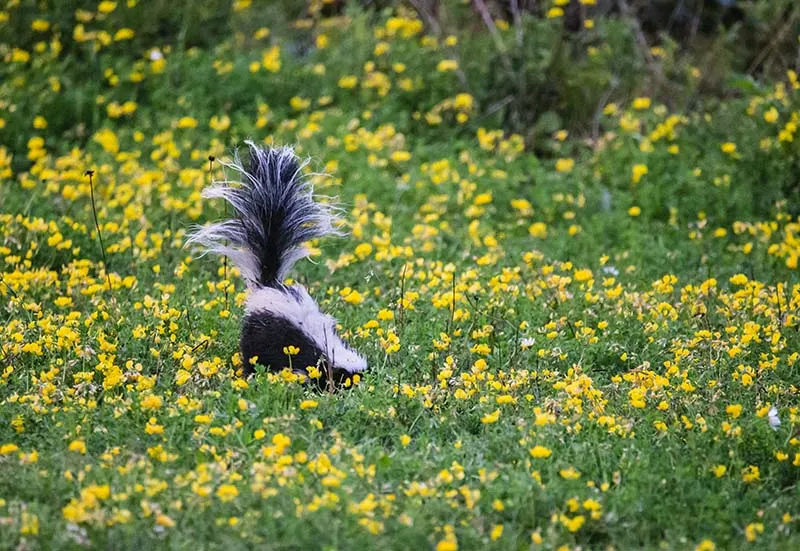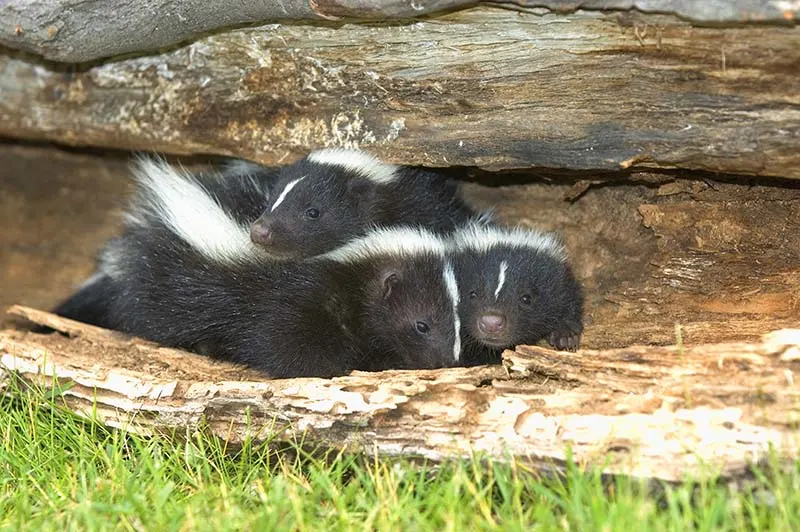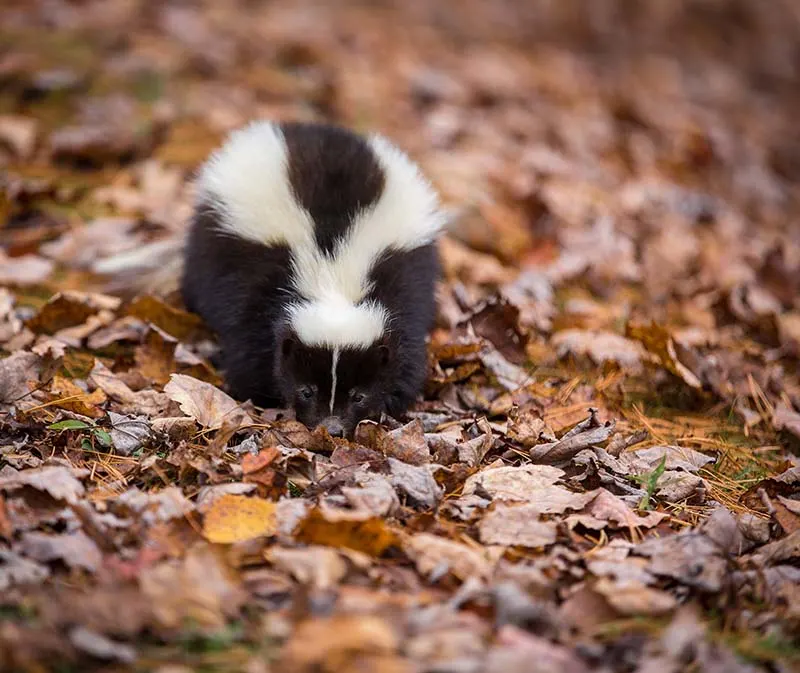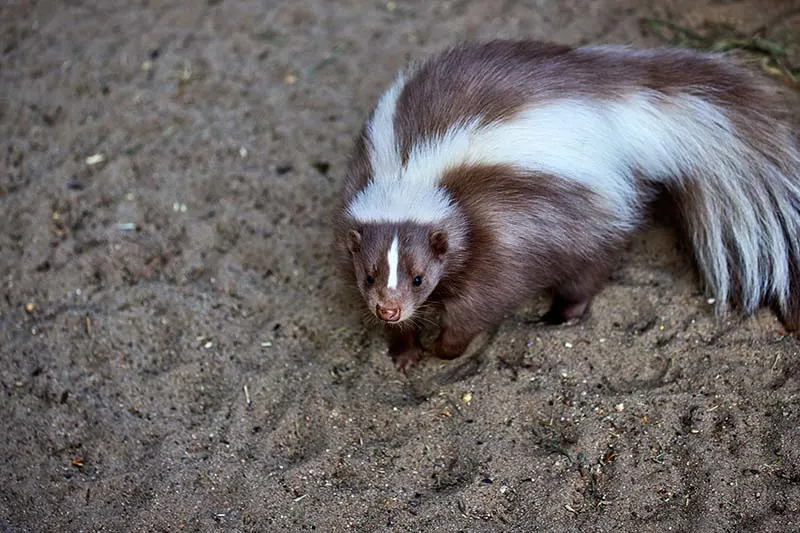Want to get to know these black and white striped creatures? This is the place for you! Learn all kinds of interesting facts about skunks in this post.

While skunks are well known for their smelly spray, there is much more to them! Read on to learn more about the gentle, burrow-loving, pest-eating skunk.
Physical Description
There are a few different species of skunk, but, in general, skunks are about the size of a house cat. Including their tail, they can range from 14 – 32 inches long and usually weigh about 8 pounds.
The striped skunk is jet black with two white stripes that run down its back. The spotted skunk is black or grayish black, with white stripes on its shoulders and sides, and white spots on its forehead, cheeks, and behind.
One of the interesting facts about skunks is that they have short, stocky legs and well-developed claws that help them dig for food.
Habitat
Skunks are found in Canada, the United States, Mexico, and South America. They can be found in rural and suburban areas. Skunks live in underground dens which can be found under wood and rock piles, buildings, porches, and concrete slabs—also in rock crevices, culverts, drainpipes, and in standing or fallen hollow trees.
While they can dig their own den, they often find deserted dens of other animals. Skunks are usually found within two miles of a water source for drinking water and prey such as fish and frogs.
Skunk Habits
Skunks are mild-tempered and nocturnal. They’ll defend themselves only if cornered or attacked. Did you know these facts about skunks? I didn't!

Skunks are slow-moving, careful and are confident in their ability to defend themselves. Most skunks will ignore other animals or people unless they’re disturbed.
Facts about Skunks' Diet
Skunks are omnivores. That means they eat both meat and vegetation. They feed on what most people consider garden pests. This makes them especially helpful to farmers and gardeners.
Their favorite foods include: mice, moles, voles, rats, birds and their eggs, grasshoppers, wasps, bees, crickets, beetles, and beetle larvae. They also enjoy fruits, nuts, garden crops, and scavenge on garbage, birdseed, and pet food.
Offspring
Striped skunks breed from February through March. Spotted skunks breed from September through October. Male skunks may travel 4 to 5 miles each night during breeding season.

In late April and May, females of both species give birth to four to five young, called kits, in their dens. At about two months old, mothers teach their offspring how to forage and hunt for food. By three months old the offspring are almost full-grown and completely independent.
Classification/Taxonomy
Kingdom: Animalia
Subkingdom: Bilateria
Infrakingdom: Deuterostomia
Phylum: Chordata
Subphylum: Vertebrata
Infraphylum: Gnathostomata
Superclass: Tetrapoda
Class: Mammalia
Subclass: Theria
Infraclass: Eutheria
Order: Carnivora
Suborder: Caniformia
Family: Mephitidae
Genera:
- Conepatus (hog-nosed skunks)
- Mephitis (hooded skunks, striped skunks)
- Spilogale (spotted skunks)
- Mydaus (stink badgers)
There are 11 species of skunk. The scientific name for the most common species is Mephitis mephitis. Mephitis is Latin for poisonous smell.
Facts about Skunks' History
The oldest fossil identified as a skunk was discovered in Germany and dates to 11–12 million years ago. Genetic data indicate the family originated about 30–40 million years ago.
Predators
Skunks don’t have many predators but the ones they have include: coyotes, foxes, bobcats, and cougars, and large owls. Dogs have also been known to kill skunks. Bald eagles and golden eagles are also predators of skunks.

Lifespan
Striped skunks usually live three to four years and spotted skunks live about one and a half to two years.
More Facts about Skunks
- The odor of skunk spray (also called musk) is pungent, nauseating, and can cause severe reactions in some people. The spray is discharged from their anal glands, they can discharge multiple times, and up to 10 feet.
- Skunks will usually stamp their front feet and arch their tail over their back before spraying their musk.
- Skunks will roll caterpillars on the ground to remove the hairs before eating them. They will also roll beetles that emit a defensive scent, causing the beetle to deplete its scent before they eat it.
- Skunks don’t hibernate, but in extreme cold, they will plug their den entrance with leaves and grass to insulate them from the cold and lower their body temperature.
- Skunks can carry rabies and any skunk displaying abnormal behavior, like day-time activity, should be treated with caution and reported to animal control or local law enforcement.
- Skunks can make noise including screeching, whimpering, and chirping.
- Skunks are sometimes call polecats.
- Skunks are not affected by snake venom.
- A group of skunks is called a surfeit.
- A skunk can travel up to 10 miles per hour.
- In the United States there are 17 states where it is legal to keep a skunk as a pet.
- Skunks eat wasps and honeybees, and will often attack beehives.

- Although skunks have very poor eyesight, they have excellent senses of smell and hearing.
- Stink badgers, which occur in Indonesia and the Philippines, have just recently been considered part of the skunk family.
- The Eastern spotted skunk is the only skunk that can climb trees.
- It can take over a week for a skunk to reload their scent glands so they spray only when necessary.
- The earliest legislation for the protection of skunks was initiated by hop growers in New York in 1894.
- The city of Chicago is named for the skunk. Early French explorers derived “Chicago” from the Ojibwe Indian word “Zhigaagong,” meaning “on the skunk.”
- In the 1920s skunk pelts were the second most valuable fur export in the Americas after muskrat but have since fell out of popularity.
- Skunks hate certain smells! Citrus, ammonia, mothballs and predator urine (dog, coyote, etc.) are all repellent to skunks and can be used to deter them from your property.
- Skunk spray is comprised of thiols, the same sulfur-based compounds found in garlic and onions, and is highly flammable.
- If you or your pet are sprayed by a skunk, contrary to popular belief, tomato juice will not remove the scent. However, a mixture of baking soda and hydrogen peroxide should do the trick.
- One in every 1000 people has no ability to detect skunk spray due to a condition called anosmia, or insensitivity to one particular smell.
- Skunk stripes markings draw the eye of potential predators towards the most dangerous part of themselves as a deterrent.
- Because skunks like to use burrows that already exist, skunks may coexist with woodchucks in separate chamber systems within a burrow – often without one being aware of the other.
Check out these other cool mammals!
